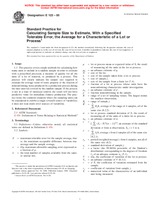We need your consent to use the individual data so that you can see information about your interests, among other things. Click "OK" to give your consent.
ASTM E122-00
Standard Practice for Calculating Sample Size to Estimate, With a Specified Tolerable Error, the Average for Characteristic of a Lot or Process
STANDARD published on 10.10.2000
The information about the standard:
Designation standards: ASTM E122-00
Note: WITHDRAWN
Publication date standards: 10.10.2000
SKU: NS-40905
The number of pages: 5
Approximate weight : 15 g (0.03 lbs)
Country: American technical standard
Category: Technical standards ASTM
Annotation of standard text ASTM E122-00 :
Keywords:
calculating test values, empirical knowledge, sampling, size, statistical methods, ICS Number Code 03.120.30 (Application of statistical methods)
Additional information
| Significance and Use | ||
|
This practice is intended for use in determining the sample size required to estimate, with specified precision, a measure of quality of a lot or process. The practice applies when quality is expressed as either the lot average for a given property, or as the lot fraction not conforming to prescribed standards. The level of a characteristic may often be taken as an indication of the quality of a material. If so, an estimate of the average value of that characteristic or of the fraction of the observed values that do not conform to a specification for that characteristic becomes a measure of quality with respect to that characteristic. This practice is intended for use in determining the sample size required to estimate, with specified precision, such a measure of the quality of a lot or process either as an average value or as a fraction not conforming to a specified value. |
||
| 1. Scope | ||
|
1.1 This practice covers simple methods for calculating how many units to include in a random sample in order to estimate with a prescribed precision, a measure of quality for all the units of a lot of material, or produced by a process. This practice will clearly indicate the sample size required to estimate the average value of some property or the fraction of nonconforming items produced by a production process during the time interval covered by the random sample. If the process is not in a state of statistical control, the result will not have predictive value for immediate (future) production. The practice treats the common situation where the sampling units can be considered to exhibit a single (overall) source of variability; it does not treat multi-level sources of variability. |
||
| 2. Referenced Documents | ||
|
We recommend:
Technical standards updating
Do you want to make sure you use only the valid technical standards?
We can offer you a solution which will provide you a monthly overview concerning the updating of standards which you use.
Would you like to know more? Look at this page.




 Cookies
Cookies
